MODERNISM: Vatican’s Exhibition Boasts the
Church of the Future
In this year’s Venice Architecture Biennale, the Vatican outdoes itself in proving its adaptation to the modern world. Vatican involvement in this avant-garde,
ugly display of structures is enthusiastically explained as being yet
“another step towards healing the rift between the spiritual and the
secular” by Cardinal Gianfranco Ravasi, president of the Pontifical
Council for Culture.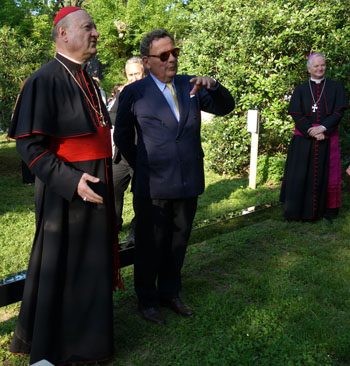
Card. Ravasi, left, with curator Francesco Dal Co, at the unveiling of the Vatican's exhibition space
At the 2015 show, in the Vatican’s central space there was an ongoing reading of Marx’ Das Kapital and a room exhibiting voodoo heads and obscene nude “porn dollies.”
This year the Vatican marked another first by making a contribution to the Venice Biennial Architectural event. Card. Ravasi hired 10 leading-edge architects to design 10 temporary chapels (obviously not an inexpensive project). Normally I am firmly opposed to the conciliar Pope’s efforts to diminish and minimize the Church by selling her riches to give to the poor; in this case, I believe the money spent for this extravagant and imbecile enterprise would have been better spent on alms.
An ecumenical space
On May 27 at 6 p.m. Venice time, the Vatican unveiled its 10 chapels in the outdoor space assigned to it – a wooded area on the of San Giogio Maggiore Island. The crowd was dense as the line formed to be ushered through the first view of the “prayer spaces."
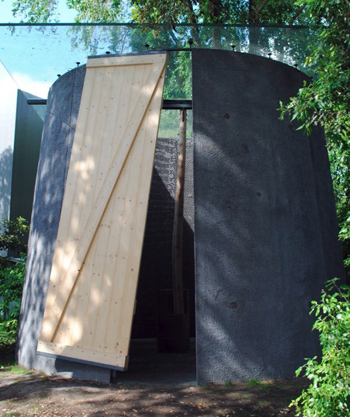
This open-roof silo structure is supposed to be a roadside shrine, or "tribalized chapel"
The so-called Catholic chapels are thus planned to be totally ecumenical, with the only acceptable symbol a plain cross so as not to provoke the sensibilities of Protestants, Muslims, Jews, Buddhists, etc.
When the project was announced in March, Card. Ravasi said that visiting the 10 chapels would serve as a sort of “pilgrimage.” That this is not a Catholic religious pilgrimage is obvious from the start.
Monstrosities unveiled
Brazilian architect Carla Juaçaba’s contribution, below left, represents the minimalist, better said Miserablist Church to the tee. That’s all there is to it, a single polished steel plank T-shaped structure that can or cannot be a cross, depending on your opinion.
Rivaling it in witless simplicity is the carport structure designed by New York architect Andrew Berman, below right. This chapel made of wood and polycarbonate is his first “explicitly religious building,” although I don’t know what the normal man can find of religious in this communist shed.
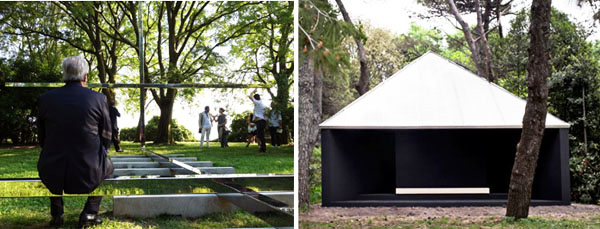
Portugal’s Eduardo Souto de Moura’s contribution below was an underground “space” enclosed by four stone walls, and benches on the side so the visitors can sit and contemplate a stone at the center that alludes to an altar. The covering for this subterranean room looks more like a bus stop with outdoor lavatories than anything to do with the Catholic Religion prior to Vatican II.
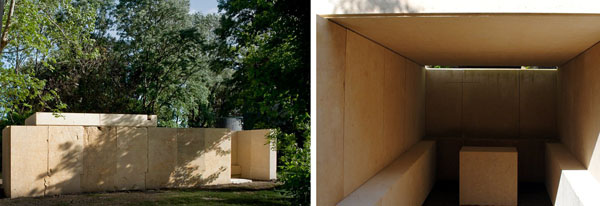
A crossbeam serves as an obscure cross in British designer Norman Foster’s slatted wood frame "chapel," below left. Here one is asked to meditate not on Christ but rather on the nearby forest and water. It is a "nature sanctuary.” The architect's explicit aim is to move worship outside the traditional chapel to the “water and sky beyond.”
To the right below, you find Australian Sean Godsell's pop-up chapel, a strange silo-like structure that rests on a carport. It can be transported, erected, re-packed, transported, re-erected again wherever the need exists. The notion of a stable and beautiful Church that calls people by its grandeur to enter and contemplate God and His mysteries has completely disappeared.
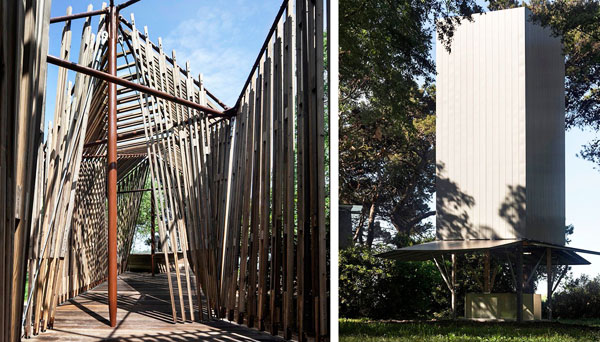
Altogether, says the Vatican, the choice of architects and their creations reflect “the universal – indeed Catholic – nature of the Church.”
Predicted Church of the Future
Actually, it is the Church of Vatican II, predicted by and approved by then Fr. Joseph Ratzinger in 1969:
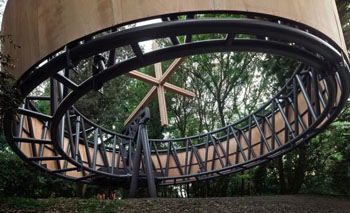
Corvalán "liberates the circle" with his nomadic church, always on the move. The circle does not touch the ground but hovers in the air, moved by the wind
Venice, the city nicknamed La Serenissima, famous for its wealth of glorious churches that majestically rise to animate the city’s skyline, certainly becomes less serene with this display of mutant monsters called chapels that the present day Vatican proudly sponsors as the Churches of the Future.
The ensemble calls to my mind the text from the Third Secret of Fatima posted on this website as deciphered by Atila Guimarães. In it, Sister Lucy writes: “Then, after some moments, we saw the Pope entering a Church, but this Church was the Church of Hell. There is no way to describe the ugliness of that place.”
